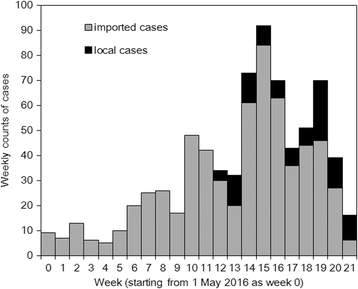Estimating the subcritical transmissibility of the Zika outbreak in the State of Florida, USA, 2016
- PMID: 27829439
- PMCID: PMC5103397
- DOI: 10.1186/s12976-016-0046-1
Estimating the subcritical transmissibility of the Zika outbreak in the State of Florida, USA, 2016
Abstract
Background: Florida State has reported autochthonous transmission of Zika virus since late July 2016. Here we assessed the transmissibility associated with the outbreak and generated a short-term forecast.
Methods: Time-dependent dynamics of imported cases reported in the state of Florida was approximated by a logistic growth equation. We estimated the reproduction number using the renewal equation in order to predict the incidence of local cases arising from both local and imported primary cases. Using a bootstrap method together with the logistic and renewal equations, a short-term forecast of local and imported cases was carried out.
Results: The reproduction number was estimated at 0.16 (95 % Confidence Interval: 0.13, 0.19). Employing the logistic equation to capture a drastic decline in the number of imported cases expected through the course of 2016, together with the low estimate of the local reproduction number in Florida, the expected number of local reported cases was demonstrated to show an evident declining trend for the remainder of 2016.
Conclusions: The risk of local transmission in the state of Florida is predicted to dramatically decline by the end of 2016.
Keywords: Basic reproduction number; Epidemic; Mathematical model; Prediction; Zika virus.
Figures


References
-
- Centers for Disease Control and Prevention (USA). Florida investigation links four recent Zika cases to local mosquito-borne virus transmission [Internet]. Accessed 7 Nov 2016. Available from: http://www.cdc.gov/media/releases/2016/p0729-florida-zika-cases.html
-
- Florida Department of Health (USA). Department of Health Daily Zika Update, 26 September 2016 [Internet]. Accessed 7 Nov 2016. Available from: http://www.floridahealth.gov/newsroom/2016/09/092616-zika-update.html
-
- Florida Department of Health (USA). Department of Health’s Zika testing, investigation and notification process [Internet]. Accessed 7 Nov 2016. Available from: http://www.floridahealth.gov/diseases-and-conditions/zika-virus/_documen...
-
- Majumder MS, Cohn E, Fish D, Brownstein JS. Estimating a feasible serial interval range for Zika fever. Bull WHO. 2016;in press. doi:10.2471/BLT.16.170860
Publication types
MeSH terms
Grants and funding
LinkOut - more resources
Full Text Sources
Other Literature Sources
Medical

